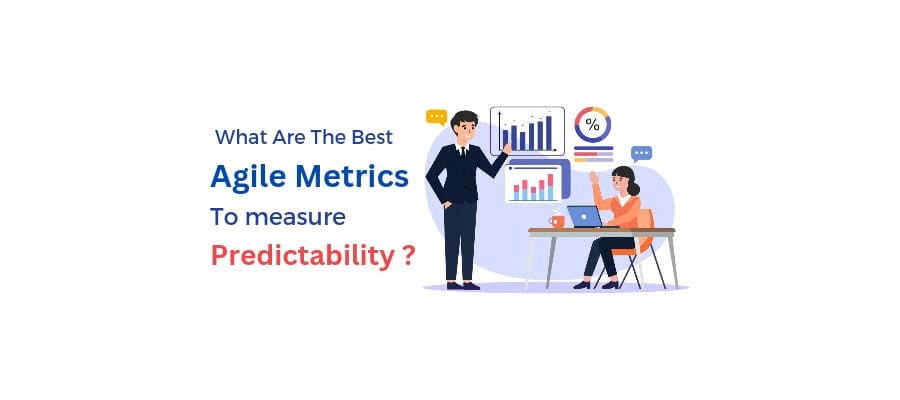What Are The Best Agile Metrics To Measure "Predictability"?

Have you ever wondered why some Agile projects flow effortlessly while others encounter constant roadblocks? The answer often lies in predictability—the ability to forecast outcomes with confidence.
Are you also struggling to predict project outcomes accurately in your Agile endeavors? Do unexpected deviations from plans hinder your team's development progress? If so, you're not alone!
Predictability is a concern for many Agile teams, and measuring it effectively can make all the difference in project success. But what are the best Agile metrics to gauge predictability? Let's explore through today’s discussion!
What Does Predictability Signify From The Agile Perspective?
Predictability refers to the team's ability to consistently deliver value at a sustainable pace that meets stakeholder expectations and team commitments. Predictability is an essential element for meeting deadlines and ensuring sustainable product delivery. Agile Leaders and Product Owners are responsible for measuring the team’s success predictability using Agile Metrics.
Measuring predictability encompasses factors such as meeting the Sprint Goals and delivering the product Feature on time. It also signifies how the Agile Teams succeed in maintaining a stable process velocity. Predictability serves as a barometer of the team's effectiveness in planning and executing various product development activities throughout the project lifecycle.
Why Should You Measure Predictability?
- Improved Planning: By measuring predictability, teams can better forecast future outcomes, enabling more accurate planning and resource allocation.
- Enhanced Risk Management: Predictability metrics highlight potential plan deviations, allowing teams to mitigate risks and proactively avoid project delays.
- Increased Stakeholder Confidence: Consistent delivery builds trust with stakeholders, fostering stronger relationships and garnering support for Agile initiatives.
Utilizing Agile Metrics To Measure “Predictability”
Agile metrics are quantitative data points used to assess various aspects of Agile project performance, such as productivity, quality, and predictability. These metrics provide teams and stakeholders valuable insights into their progress and help drive continuous improvement.
Now, let's explore some key Agile metrics for measuring predictability:
1. Velocity
Velocity measures the amount of teamwork developers finish in each sprint. By tracking velocity over multiple sprints, teams can establish a predictable cadence for delivery. Consistent velocity indicates a stable team performance and enhances predictability.
2. Sprint Burndown Chart
A Sprint Burndown Chart tracks the remaining work in a sprint against time. A steady downward trend indicates progress toward completing all planned work by the end of the sprint, enhancing predictability.
3. Cycle Time
Cycle Time measures the time it takes for a user story to move from start to finish, including development and testing. Shorter cycle times signify faster delivery and improved predictability in meeting sprint goals.
4. Cumulative Flow Diagram (CFD)
A Cumulative Flow Diagram visualizes the flow of work items through various stages of the development process. By analyzing the CFD, teams can identify bottlenecks, optimize workflow, and improve predictability in delivering value.
5. Lead Time
Lead Time measures the total time it takes to complete a user story from its entry into the backlog until it is delivered. Monitoring lead time helps teams forecast delivery dates accurately and enhances predictability.
6. Burnup Chart
A Burnup Chart depicts the total scope of work against completed work over time. By comparing planned versus actual progress, teams can assess their ability to meet commitments and improve predictability in achieving project goals.
It’s Time To Choose Your Agile Metrics Wisely & Measure "Predictability"
“Predictability” is all about the ability to plan and deliver! Hence, selecting the right Agile metrics to measure Predictability is essential. As organizations strive to measure predictability, they must focus on metrics that align with key success levers. Avoid falling into the "vanity metrics" trap and prioritize those offering actionable value.
Choose metrics that reflect the organization's overarching objectives, such as value delivery and productivity goals. Select metrics reflecting the team's ability to plan and deliver consistently, enhancing predictability.
Thus, you can select Agile metrics wisely for your Agile teams. But remember, it's not just about collecting data—it's about leveraging Agile Metrics effectively to make informed decisions and achieve desired outcomes.
Reference:
https://www.scrum.org/resources/blog/agile-metrics-good-bad-and-ugly
https://www.atlassian.com/agile/project-management/metrics



